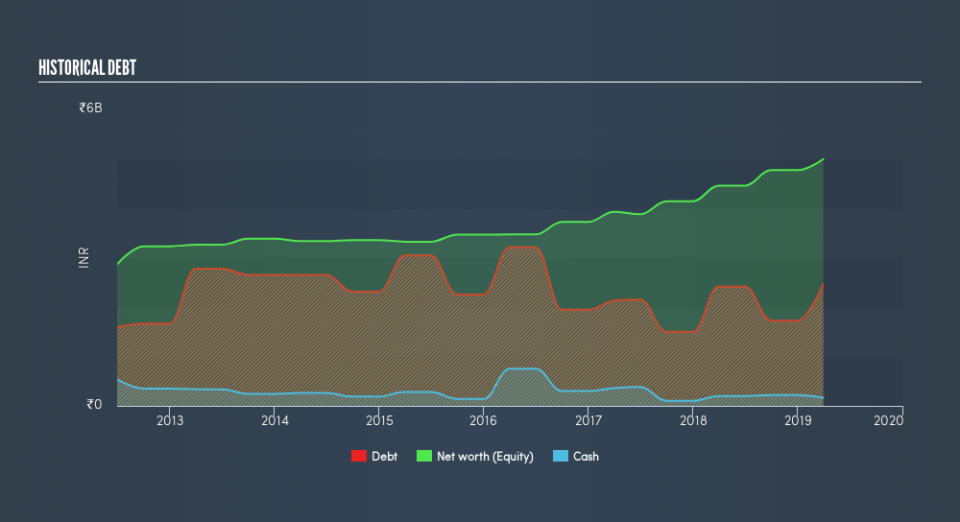What Investors Should Know About Visaka Industries Limited's (NSE:VISAKAIND) Financial Strength

Want to participate in a short research study? Help shape the future of investing tools and you could win a $250 gift card!
While small-cap stocks, such as Visaka Industries Limited (NSE:VISAKAIND) with its market cap of ₹6.5b, are popular for their explosive growth, investors should also be aware of their balance sheet to judge whether the company can survive a downturn. Evaluating financial health as part of your investment thesis is vital, as mismanagement of capital can lead to bankruptcies, which occur at a higher rate for small-caps. The following basic checks can help you get a picture of the company's balance sheet strength. However, potential investors would need to take a closer look, and I suggest you dig deeper yourself into VISAKAIND here.
VISAKAIND’s Debt (And Cash Flows)
VISAKAIND's debt level has been constant at around ₹2.5b over the previous year – this includes long-term debt. At this current level of debt, VISAKAIND currently has ₹166m remaining in cash and short-term investments to keep the business going. Additionally, VISAKAIND has produced cash from operations of ₹709m in the last twelve months, resulting in an operating cash to total debt ratio of 29%, signalling that VISAKAIND’s debt is appropriately covered by operating cash.
Can VISAKAIND pay its short-term liabilities?
Looking at VISAKAIND’s ₹3.3b in current liabilities, it seems that the business has maintained a safe level of current assets to meet its obligations, with the current ratio last standing at 1.5x. The current ratio is the number you get when you divide current assets by current liabilities. Usually, for Basic Materials companies, this is a suitable ratio since there is a bit of a cash buffer without leaving too much capital in a low-return environment.
Can VISAKAIND service its debt comfortably?
VISAKAIND is a relatively highly levered company with a debt-to-equity of 49%. This is somewhat unusual for small-caps companies, since lenders are often hesitant to provide attractive interest rates to less-established businesses. We can test if VISAKAIND’s debt levels are sustainable by measuring interest payments against earnings of a company. Ideally, earnings before interest and tax (EBIT) should cover net interest by at least three times. For VISAKAIND, the ratio of 6.33x suggests that interest is appropriately covered, which means that lenders may be inclined to lend more money to the company, as it is seen as safe in terms of payback.
Next Steps:
Although VISAKAIND’s debt level is towards the higher end of the spectrum, its cash flow coverage seems adequate to meet obligations which means its debt is being efficiently utilised. Since there is also no concerns around VISAKAIND's liquidity needs, this may be its optimal capital structure for the time being. I admit this is a fairly basic analysis for VISAKAIND's financial health. Other important fundamentals need to be considered alongside. I suggest you continue to research Visaka Industries to get a more holistic view of the small-cap by looking at:
Future Outlook: What are well-informed industry analysts predicting for VISAKAIND’s future growth? Take a look at our free research report of analyst consensus for VISAKAIND’s outlook.
Valuation: What is VISAKAIND worth today? Is the stock undervalued, even when its growth outlook is factored into its intrinsic value? The intrinsic value infographic in our free research report helps visualize whether VISAKAIND is currently mispriced by the market.
Other High-Performing Stocks: Are there other stocks that provide better prospects with proven track records? Explore our free list of these great stocks here.
We aim to bring you long-term focused research analysis driven by fundamental data. Note that our analysis may not factor in the latest price-sensitive company announcements or qualitative material.
If you spot an error that warrants correction, please contact the editor at editorial-team@simplywallst.com. This article by Simply Wall St is general in nature. It does not constitute a recommendation to buy or sell any stock, and does not take account of your objectives, or your financial situation. Simply Wall St has no position in the stocks mentioned. Thank you for reading.


